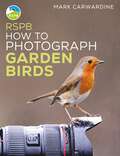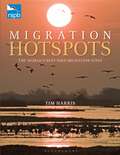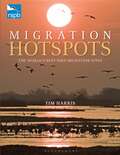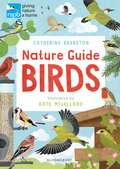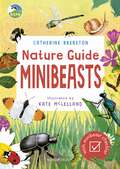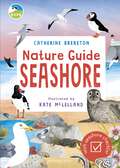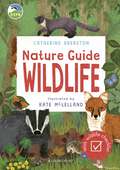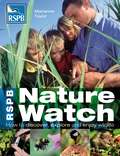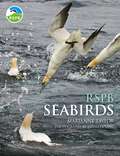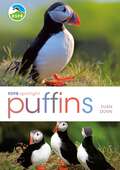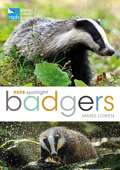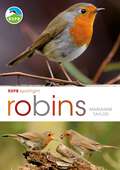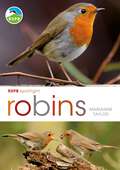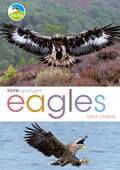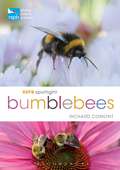- Table View
- List View
RSPB How to Photograph Garden Birds (RSPB)
by Mark CarwardineThis accessible, practical guide includes everything you need to know to capture fantastic photographs of birds on your doorstep.In RSPB How to Photograph Garden Birds, celebrated photographer and wildlife writer Mark Carwardine shares his expert advice and insider tips and tricks for capturing the perfect photo. Whether you have a professional camera and a garden filled with birds, or a smartphone and access to a bird table, his guidance will improve your photography in leaps and bounds.Packed with beautiful photographs, this book is a step-by-step masterclass on garden bird photography – from attracting different species to using artificial rain and capturing spectacular images of birds in flight.Once you've mastered the basics, you can make garden bird photography as simple or as challenging as you like. A robin perched on a garden spade? Easy. A blackbird feeding among fallen leaves? No problem. A blue tit in flight? Might take some planning but still very achievable.And there's more. Garden bird photography isn't only rewarding in its own right – it's also a sensational way to hone wildlife photography and field skills that you can then adapt to suit any subject anywhere in the world.
RSPB Migration Hotspots: The World's Best Bird Migration Sites (RSPB)
by Tim HarrisEach spring and autumn hundreds of millions of birds - wildfowl, shorebirds, raptors, and passerines - migrate between higher and lower latitudes, or in some cases between high latitudes in the northern hemisphere and high latitudes in the southern hemisphere. In a handful of places around the world, a combination of geography, topography and climate combine to funnel migrant birds into narrow fronts, leading to migration hotspots, places where, for a few days each year, birds seem to be everywhere. The sight of thousands upon thousands of birds is one of nature's greatest wildlife spectacles.Migration Hotspots takes a look at 30 of the locations where the planet's most dramatic bird migration can be witnessed, from raptor bottlenecks such as Veracruz (Mexico) and the Strait of Messina (Italy) to places like Point Pelée (Canada) and Beidaihe (China) where spectacular falls of songbirds can take place. And from wetlands where huge numbers of waders stop over each spring and autumn to the great rarity islands of Scilly and Heligoland.The book covers each of the world's major avian flyways and features stunning photography throughout. The geographical reasons for the importance of each hotspot are explained, with a summary of the different birds that pass through and the best times of year to see them, and an introductory chapter summarises birds' migration strategies.
RSPB Migration Hotspots: The World's Best Bird Migration Sites (RSPB)
by Tim HarrisEach spring and autumn hundreds of millions of birds - wildfowl, shorebirds, raptors, and passerines - migrate between higher and lower latitudes, or in some cases between high latitudes in the northern hemisphere and high latitudes in the southern hemisphere. In a handful of places around the world, a combination of geography, topography and climate combine to funnel migrant birds into narrow fronts, leading to migration hotspots, places where, for a few days each year, birds seem to be everywhere. The sight of thousands upon thousands of birds is one of nature's greatest wildlife spectacles.Migration Hotspots takes a look at 30 of the locations where the planet's most dramatic bird migration can be witnessed, from raptor bottlenecks such as Veracruz (Mexico) and the Strait of Messina (Italy) to places like Point Pelée (Canada) and Beidaihe (China) where spectacular falls of songbirds can take place. And from wetlands where huge numbers of waders stop over each spring and autumn to the great rarity islands of Scilly and Heligoland.The book covers each of the world's major avian flyways and features stunning photography throughout. The geographical reasons for the importance of each hotspot are explained, with a summary of the different birds that pass through and the best times of year to see them, and an introductory chapter summarises birds' migration strategies.
RSPB Nature Guide: Birds
by Catherine BreretonDo you know that cormorants are expert fishers? They swim along the water and then quickly dive to catch their prey! Or that great crested grebes fluff up their feathers and break out into a dance to attract their mates?From the easy-to-spot, year-round tufted duck to the summer visitor and cackling fulmar, get ready to find out about 137 different birds. There are so many feathered friends to meet in this children's spotter's field guide, published in collaboration with the RSPB, the largest wildlife conservation charity in Europe. You will learn where to find birds, what different bird habitats look like and which birds to look out for throughout different seasons. Including our favourite birds, such as the goldfinch, robin, blue tit, blackbird and even owl, as well as some less common visitors we might not know of, each page contains information boxes about each bird.With beautiful illustrations by Kate McLelland throughout, this is the perfect contemporary pocket guide for young birdwatchers in-the-making and adult nature enthusiasts alike.
RSPB Nature Guide: Minibeasts
by Catherine BreretonWhether in your garden, kitchen, bathroom or under a log in the woods, minibeasts are everywhere to be found! So grab this handy nature guide and explore every nook and cranny you can find, there might just be a surprise.Did you know that honey bees have a special stomach for honey? Or that butterflies got their name from butter?From gorgeous orange-tip butterflies to the fierce-looking stag beetle, get ready to find out about over 190 different minibeasts and bugs. There are so many wonderful living things to meet in this children's spotter's guide, published in collaboration with the RSPB, the largest wildlife conservation charity in Europe.You will learn what a dragonfly's lifecycle looks like, which habitat each insect enjoys most and what kind of minibeasts you may be likely to spot each season. This guide covers all grounds when it comes to minibeast-watching. Whether you're in a city park or on a walk in the woods, don't ever leave your RSPB Nature Guide: Minibeasts at home! Includes information on how to make your green space bug friendly, activities such as making a wormery and a minibeast checklist so you can tick off everything you spot!With beautiful and life-like illustrations by Kate McLelland throughout, this is the perfect contemporary pocket guide for young wildlife watchers and adult nature enthusiasts alike. This is the third book in the RSPB Nature Guide series, following Birds and Wildlife.
RSPB Nature Guide: Seashore
by Catherine BreretonA beautifully illustrated seashore spotter's guide that both children and adults will love to take to the beach, published in collaboration with the RSPB. Ideal for children aged 5+_______________Did you know that jellyfish have no brain, heart or blood? Or that there's an animal called a sea potato?Come rain or shine there is always something interesting to spot at the seaside! Grab this handy nature guide and head to the beach to explore the wonders of the seashore.Nature Guide Seashore is jam-packed with facts – you'll learn that seaweed is used to make ice cream, and that grey seals can eat 10kg of fish a day (that's about the weight of two bowling balls!). From bright-beaked puffins and sunbathing seals to slippery seaweed and limpets clinging to rocks, there are over 200 different animals, plants and other wildlife to discover in this spotter's guide. Discover how to be a wildlife detective, what animals you might find when you go rock pooling and tips on how to look after our coastline. Includes easy to look up fact boxes, a checklist to tick off everything you spot and activities such as making sand art. What will you spot? _______________Full of charming and life-like illustrations by Kate McLelland, RSPB Nature Guide: Seashore is the perfect contemporary spotter's guide for young wildlife watchers. Published in collaboration with the RSPB, the largest wildlife conservation charity in Europe, this is the fourth book in the RSPB Nature Guide series, following Birds, Wildlife and Minibeasts.
RSPB Nature Guide: Wildlife
by Catherine BreretonDo you know that rabbits eat their own poo? That butterflies taste with their feet? Or that starfish aren't actually fish? This trusty companion guide uncovers all the mysteries of the extraordinary wildlife that surrounds us. From gorgeous foxgloves and strong oaks to wild foxes and slow snails, get ready to find out over 195 different animals, plants and other wildlife. There are so many wonderful living things to meet in this children's spotter's field guide, published in collaboration with the RSPB, the largest wildlife conservation charity in Europe.You will learn what a butterfly's lifecycle looks like, what pretty flowers grow commonly in gardens and which mushrooms are best to steer clear from … they may be poisonous! This guide covers all grounds when it comes to nature. Whether you're in a city park or on a walk in the woods, don't ever leave your RSPB Nature Guide: Wildlife at home! With beautiful illustrations by Kate McLelland throughout, this is the perfect contemporary pocket guide for young wildlife watchers in-the-making and adult nature enthusiasts alike.
RSPB Nature Watch: How to discover, explore and enjoy wildlife (RSPB)
by Ms Marianne TaylorWhether you're just starting out or a seasoned wildlife watcher, this book will help you to broaden your enjoyment of your hobby and explore wildlife in a range of different habitats and environments.You'll learn a host of techniques including observing without disturbing, different ways of recording what you see, including note-taking, sketching and photography, filming and sound recording, as well as how to organise and report what you've seen.Finally, there's plenty of information on how you can give something back to the natural environment through safeguarding your local area's wildlife and involvement with conservation.
RSPB Seabirds (RSPB)
by Marianne Taylor David TiplingSeabirds are the living links between land, air and sea. They enjoy a freedom that even humans, with all our technological assistance, can barely imagine. Many species travel mind-boggling distances across the length and breadth of our planet before returning to land to breed in large, deafening and confusingly crowded colonies. Yet within this commotion each mated pair forms a bond of extreme closeness and tenderness that survives separation each winter and may persist for decades. The long and geologically varied coastline of the British Isles provides homes for internationally important numbers of breeding seabirds. Visiting their colonies is always unforgettable, whether they are cliff-faces packed with Guillemots, islands white-capped by clustered Gannets on their nests, flat beaches crowded with screaming Arctic Terns or seaside rooftops overlaid with a second townscape of nesting gulls. The changing fortunes of these seabird cities reveal to us the health of the vast, unseen but incredibly rich marine world that surrounds us. RSPB Seabirds showcases some of our most exciting and enigmatic bird species as vital and living components of one of our greatest natural assets: our coastline. The author presents detailed biographies of all the seabird species that breed in and around the British Isles, and also looks at the many species that breed elsewhere but which, regularly or occasionally, visit British waters. Every page of this sumptuous book features beautiful photographs of wild seabirds engaged in their daily work of hunting, travelling, protecting themselves and their territories, courting and raising a family.
RSPB Seabirds (Rspb Ser.)
by Ms Marianne Taylor David TiplingSeabirds are the living links between land, air and sea. They enjoy a freedom that even humans, with all our technological assistance, can barely imagine. Many species travel mind-boggling distances across the length and breadth of our planet before returning to land to breed in large, deafening and confusingly crowded colonies. Yet within this commotion each mated pair forms a bond of extreme closeness and tenderness that survives separation each winter and may persist for decades.The long and geologically varied coastline of the British Isles provides homes for internationally important numbers of breeding seabirds. Visiting their colonies is always unforgettable, whether they are cliff-faces packed with Guillemots, islands white-capped by clustered Gannets on their nests, flat beaches crowded with screaming Arctic Terns or seaside rooftops overlaid with a second townscape of nesting gulls. The changing fortunes of these seabird cities reveal to us the health of the vast, unseen but incredibly rich marine world that surrounds us.RSPB Seabirds showcases some of our most exciting and enigmatic bird species as vital and living components of one of our greatest natural assets: our coastline. The author presents detailed biographies of all the seabird species that breed in and around the British Isles, and also looks at the many species that breed elsewhere but which, regularly or occasionally, visit British waters. Every page of this sumptuous book features beautiful photographs of wild seabirds engaged in their daily work of hunting, travelling, protecting themselves and their territories, courting and raising a family.
RSPB Spotlight: Otters (Rspb Ser.)
by Nicola ChesterOtters by Nicola Chester is an accessible and lively account of an intriguing and much-loved animal that, surprisingly, is still endangered and rarely seen despite a recent resurgence that has seen it expand from the remote countryside into our cities.Nicola's charming, informed text brings this elusive and exciting mammal into sharper focus revealing what an otter is, and how they live, feed, play and breed. Nicola reflects on how otters exist in our imaginations culturally and how that has changed over the years. She also examines the many challenges otters have faced, exposing what brought them to the brink of extinction, and explores the challenges we face in trying to find and watch otters in the wild.Each Spotlight title is carefully designed to introduce readers to the lives and behaviour of our favourite birds and mammals.
RSPB Spotlight: Otters (RSPB)
by Nicola ChesterOtters by Nicola Chester is an accessible and lively account of an intriguing and much-loved animal that, surprisingly, is still endangered and rarely seen despite a recent resurgence that has seen it expand from the remote countryside into our cities.Nicola's charming, informed text brings this elusive and exciting mammal into sharper focus revealing what an otter is, and how they live, feed, play and breed. Nicola reflects on how otters exist in our imaginations culturally and how that has changed over the years. She also examines the many challenges otters have faced, exposing what brought them to the brink of extinction, and explores the challenges we face in trying to find and watch otters in the wild.Each Spotlight title is carefully designed to introduce readers to the lives and behaviour of our favourite birds and mammals.
RSPB Spotlight: Puffins (Rspb Ser.)
by Euan DunnEnduringly popular, Puffins are perhaps our most iconic species of bird, and are the most immediately identifiable of seabirds with their decorative bills and clown-like gait. Yet when they take to the air they wheel and turn with great agility and underwater these stocky little birds use short specially adapted wings to propel themselves through the water in pursuit of small fish.Surprisingly little was known about Puffin ecology until recently thanks to their preferred breeding habitat being underground on remote islands or hard-to-reach coastlines. Now Euan Dunn discloses all we have learnt about them as a result of technological advances, and provides a revealing account of their life cycle, behaviour and breeding, what they eat, how they interact in their busy colonies, and where they migrate to in winter. Euan also exposes the mounting threats Puffins face and offers advice on the best places to see them.Each Spotlight title is carefully designed to introduce readers to the lives and behaviour of our favourite birds and mammals.
RSPB Spotlight: Puffins (RSPB)
by Euan DunnEnduringly popular, Puffins are perhaps our most iconic species of bird, and are the most immediately identifiable of seabirds with their decorative bills and clown-like gait. Yet when they take to the air they wheel and turn with great agility and underwater these stocky little birds use short specially adapted wings to propel themselves through the water in pursuit of small fish.Surprisingly little was known about Puffin ecology until recently thanks to their preferred breeding habitat being underground on remote islands or hard-to-reach coastlines. Now Euan Dunn discloses all we have learnt about them as a result of technological advances, and provides a revealing account of their life cycle, behaviour and breeding, what they eat, how they interact in their busy colonies, and where they migrate to in winter. Euan also exposes the mounting threats Puffins face and offers advice on the best places to see them.Each Spotlight title is carefully designed to introduce readers to the lives and behaviour of our favourite birds and mammals.
RSPB Spotlight: Badgers (RSPB)
by James LowenBadgers are elusive wanderers of the night and few mammals are as mysterious. Their nocturnal lifestyle meansnot many of us have ever glimpsed their monochrome form as they sniff and bustle their way through woodland or across pasture – yet most of us live far closer to a Badger group than we might think. In Spotlight: Badgers James Lowen explores all aspects of their lives including their communal living, feeding habits, as well as the major threats to and conservation support for Badgers.These iconic omnivores are widely represented in folklore and have permeated our popular culture. Generations of children have been entranced by Badger in Kenneth Grahame's book Wind in the Willows, however these determined yet mostly peaceful animals have also been loathed and persecuted for centuries. Badger baiting is thankfully now illegal, but the legal badger cull introduced in 2011 in parts of Gloucestershire and Somerset remains in place following the 2015 general election. With so much politics surrounding Badgers in the UK, it's not easy to get unbiassed information. In RSPB Spotlight: Badgers James Lowen keeps a neutral tone on the debate about Badger culling. He describes the history, from the first Badger found to be infected with bTB in 1972 and the subsequent gassing of setts from 1975 to 1982. He also outlines the RSPB's stance on the Badger cull. As one of the UK's largest landowners, the RSPB oppose Badger culling on their land, in favour of vaccination, cattle testing, bio-security and movement controls.The Spotlight series introduces readers to the lives and behaviours of our favourite animals with eye-catching, colour photography and informative expert text.
RSPB Spotlight: Badgers (RSPB)
by James LowenBadgers are elusive wanderers of the night and few mammals are as mysterious. Their nocturnal lifestyle meansnot many of us have ever glimpsed their monochrome form as they sniff and bustle their way through woodland or across pasture – yet most of us live far closer to a Badger group than we might think. In Spotlight: Badgers James Lowen explores all aspects of their lives including their communal living, feeding habits, as well as the major threats to and conservation support for Badgers.These iconic omnivores are widely represented in folklore and have permeated our popular culture. Generations of children have been entranced by Badger in Kenneth Grahame's book Wind in the Willows, however these determined yet mostly peaceful animals have also been loathed and persecuted for centuries. Badger baiting is thankfully now illegal, but the legal badger cull introduced in 2011 in parts of Gloucestershire and Somerset remains in place following the 2015 general election. With so much politics surrounding Badgers in the UK, it's not easy to get unbiassed information. In RSPB Spotlight: Badgers James Lowen keeps a neutral tone on the debate about Badger culling. He describes the history, from the first Badger found to be infected with bTB in 1972 and the subsequent gassing of setts from 1975 to 1982. He also outlines the RSPB's stance on the Badger cull. As one of the UK's largest landowners, the RSPB oppose Badger culling on their land, in favour of vaccination, cattle testing, bio-security and movement controls.The Spotlight series introduces readers to the lives and behaviours of our favourite animals with eye-catching, colour photography and informative expert text.
RSPB Spotlight: Robins
by Marianne TaylorTheir melodious voices, bright red breasts and cheeky attitudes have always endeared Robins to the public, but how much do we really know about these familiar garden visitors. The characteristic image of a Robin on a spade handle is actually a consequence of their keen territorial instincts - males are often to be seen seeking a favourable lookout post. Despite their cute appearance, Robins are aggressively territorial and because they hold their territories all year round, Robins are one of the only UK birds that can still be heard singing in our gardens on Christmas Day, which has perhaps contributed to their longstanding association with the Christmas season.In this delightful new book Marianne Taylor provides a revealing account of their life cycle, behaviour and breeding, what they eat, how they hold their territories, and she looks into the many cultural representations of these much-loved little birds.
RSPB Spotlight: Robins (RSPB)
by Ms Marianne TaylorTheir melodious voices, bright red breasts and cheeky attitudes have always endeared Robins to the public, but how much do we really know about these familiar garden visitors. The characteristic image of a Robin on a spade handle is actually a consequence of their keen territorial instincts - males are often to be seen seeking a favourable lookout post. Despite their cute appearance, Robins are aggressively territorial and because they hold their territories all year round, Robins are one of the only UK birds that can still be heard singing in our gardens on Christmas Day, which has perhaps contributed to their longstanding association with the Christmas season. In this delightful new book Marianne Taylor provides a revealing account of their life cycle, behaviour and breeding, what they eat, how they hold their territories, and she looks into the many cultural representations of these much-loved little birds.
RSPB Spotlight: Foxes (RSPB)
by Mike UnwinHero or villain? Few animals divide opinion like the Red Fox. This most successful of the world's wild canids has lived alongside people from time immemorial. Celebrated by some for its resourcefulness and lush pelt, reviled by others for plundering chicken runs and overturning bins, it has worked its way deep into Western. Behind the folklore and tabloid headlines, however, lies a remarkable natural history success story. In Spotlight: Foxes Mike Unwin explores how the Red Fox's versatility has allowed it to thrive across the northern hemisphere, from desert and mountain to farmland and urban jungle. This informative ebook covers all aspects of the Red Fox biology and lifestyle, including hunting and caching food, defending a territory, raising a litter and understanding the secrets of its complex vocalisations and body language. Finally, he examines the complex, often troubled relationship that the Fox has enjoyed and both endured with humankind, and suggests what the future might hold. The new Spotlight series introduces readers to the lives and behaviours of our favourite animals with eye-catching, colour photography and informative expert text.
RSPB Spotlight: Foxes
by Mike UnwinHero or villain? Few animals divide opinion like the Red Fox. This most successful of the world's wild canids has lived alongside people from time immemorial. Celebrated by some for its resourcefulness and lush pelt, reviled by others for plundering chicken runs and overturning bins, it has worked its way deep into Western. Behind the folklore and tabloid headlines, however, lies a remarkable natural history success story. In Spotlight: Foxes Mike Unwin explores how the Red Fox's versatility has allowed it to thrive across the northern hemisphere, from desert and mountain to farmland and urban jungle. This informative ebook covers all aspects of the Red Fox biology and lifestyle, including hunting and caching food, defending a territory, raising a litter and understanding the secrets of its complex vocalisations and body language. Finally, he examines the complex, often troubled relationship that the Fox has enjoyed and both endured with humankind, and suggests what the future might hold. The new Spotlight series introduces readers to the lives and behaviours of our favourite animals with eye-catching, colour photography and informative expert text.
RSPB Spotlight: Eagles (RSPB)
by Mike UnwinEagles are among the most impressive hunters of the animal world. Their predatory prowess and flying skills have imbued them with a romance and mystique that runs deep in our culture and has elevated them to emblems of freedom and power across the globe. At the same time, however, people have long seen eagles as competitors. Reviled by farmers and gamekeepers as snatchers of livestock, many species have been driven into decline by persecution and disturbance.Two species of eagle occur in Britain - among 60 worldwide - and are the focus of this book. The regal Golden Eagle is the definitive 'true' eagle and occurs in wilderness areas across the northern hemisphere; the even larger White-tailed Eagle, reintroduced to the UK after historic extinction, belongs to the separate 'sea eagles' genus. These two spectacular birds are both very rare – confined largely to the remote Scottish Highlands – and a sighting of either is one of the UK's most exciting and sought-after wildlife experiences.This highly readable study looks separately at both UK eagles, exploring how each is adapted as an apex predator in its own environment, and explores the relationship between the two. Separate chapters cover all aspects of the birds' biology and lifestyle, from defending their vast territories to raising their young. Fascinating secrets are revealed, including the brutal truth behind 'Cain and Abel' syndrome. The book also takes a look at other eagles around the world, placing the two UK species within this broader context. Finally, it examines the complex relationship that humans have enjoyed with eagles since time immemorial, spanning both culture and conservation, and offers expert tips on where and how you can watch these magnificent birds for yourself.The Spotlight series introduces readers to the lives and behaviours of our favourite animals with eye-catching, colour photography and informative expert text.
RSPB Spotlight Bats
by Nancy JenningsThanks to their speed, size and nocturnal habitats, bats are among the most interesting, and least understood, mammals that frequent our homes and gardens. From their ability to make sounds that are above the range of human hearing, to their reliance on echolocation to navigate objects and find prey, their unique behaviour means that bats are seldom seen or heard. With nearly 1,400 species worldwide, bats make up around 25 per cent of all mammal species. Spotlight Bats features all 17 species that live and breed in the British Isles, as well as an array of the most fascinating bats from around the world, including some of the more charismatic species such as vampire bats and fishing bats. Nancy Jennings uses up-to-date research to provide insights intothe lives of these elusive mammals, covering the biology, diversity, evolution and ecology of bats, as well as their interactions with humans and folklore. The Spotlight series introduces readers to the lives and behaviours of our favourite animals with eye-catching colour photography and informative expert text.
RSPB Spotlight Bats (Rspb Ser.)
by Nancy JenningsThanks to their speed, size and nocturnal habitats, bats are among the most interesting, and least understood, mammals that frequent our homes and gardens. From their ability to make sounds that are above the range of human hearing, to their reliance on echolocation to navigate objects and find prey, their unique behaviour means that bats are seldom seen or heard. With nearly 1,400 species worldwide, bats make up around 25 per cent of all mammal species. Spotlight Bats features all 17 species that live and breed in the British Isles, as well as an array of the most fascinating bats from around the world, including some of the more charismatic species such as vampire bats and fishing bats. Nancy Jennings uses up-to-date research to provide insights intothe lives of these elusive mammals, covering the biology, diversity, evolution and ecology of bats, as well as their interactions with humans and folklore. The Spotlight series introduces readers to the lives and behaviours of our favourite animals with eye-catching colour photography and informative expert text.
RSPB Spotlight Bumblebees
by Richard ComontBumblebees are some of our most familiar insects, and are among the few that are almost universally viewed as 'friendly' – their low buzzing is the quintessential sound of our gardens in the summertime.Spotlight Bumblebees considers all 24 UK bumblebee species, examining what made the group so successful and how circumstances have led to the survival of some species but the precipitous decline of the majority, highlighting the dangers we all face if populations continue to plummet. Separate chapters cover all aspects of bumblebees' biology and lifestyles, from spring queens emerging from dark overwintering chambers to establish their nests, to the drone swarms that herald the end of the bumblebee season. Bumblebees around the world are studied, including in the southern hemisphere where Europe's declining species can become harmful invaders. While the influence of bumblebees throughout our history and their place in our culture, from Shakespeare to Transformers, is also examined.
RSPB Spotlight Bumblebees
by Richard ComontBumblebees are some of our most familiar insects, and are among the few that are almost universally viewed as 'friendly' – their low buzzing is the quintessential sound of our gardens in the summertime.Spotlight Bumblebees considers all 24 UK bumblebee species, examining what made the group so successful and how circumstances have led to the survival of some species but the precipitous decline of the majority, highlighting the dangers we all face if populations continue to plummet. Separate chapters cover all aspects of bumblebees' biology and lifestyles, from spring queens emerging from dark overwintering chambers to establish their nests, to the drone swarms that herald the end of the bumblebee season. Bumblebees around the world are studied, including in the southern hemisphere where Europe's declining species can become harmful invaders. While the influence of bumblebees throughout our history and their place in our culture, from Shakespeare to Transformers, is also examined.
